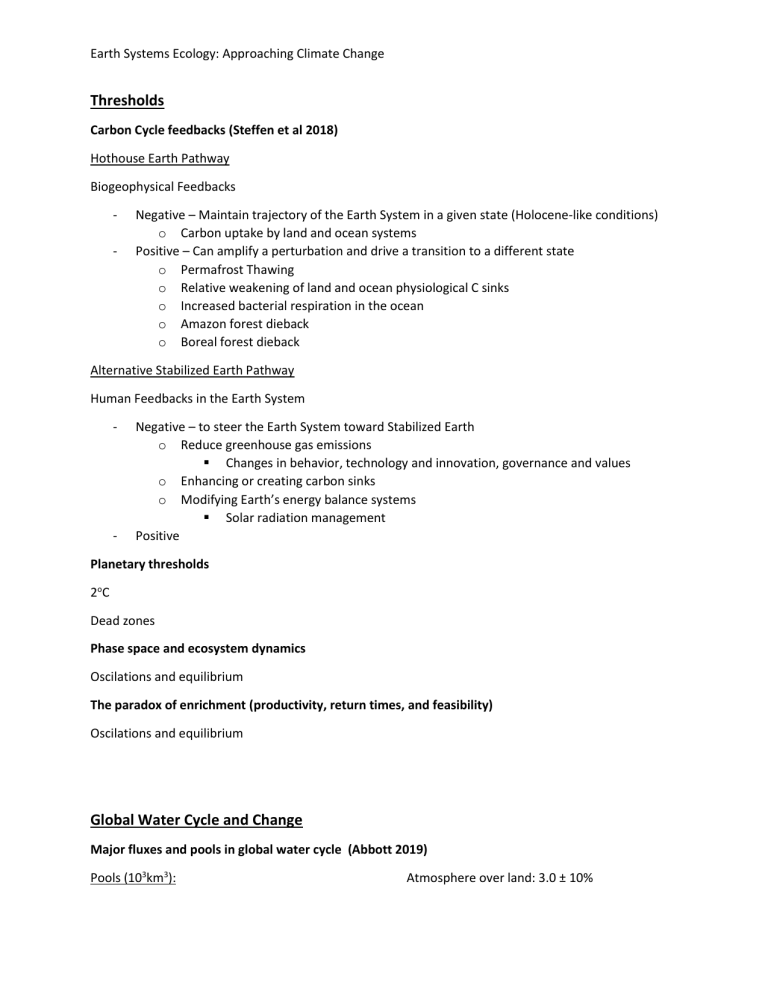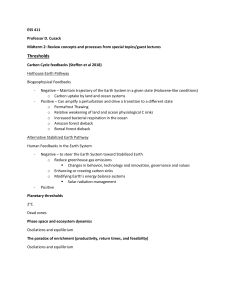
Earth Systems Ecology: Approaching Climate Change Thresholds Carbon Cycle feedbacks (Steffen et al 2018) Hothouse Earth Pathway Biogeophysical Feedbacks - Negative – Maintain trajectory of the Earth System in a given state (Holocene-like conditions) o Carbon uptake by land and ocean systems Positive – Can amplify a perturbation and drive a transition to a different state o Permafrost Thawing o Relative weakening of land and ocean physiological C sinks o Increased bacterial respiration in the ocean o Amazon forest dieback o Boreal forest dieback Alternative Stabilized Earth Pathway Human Feedbacks in the Earth System - - Negative – to steer the Earth System toward Stabilized Earth o Reduce greenhouse gas emissions Changes in behavior, technology and innovation, governance and values o Enhancing or creating carbon sinks o Modifying Earth’s energy balance systems Solar radiation management Positive Planetary thresholds 2oC Dead zones Phase space and ecosystem dynamics Oscilations and equilibrium The paradox of enrichment (productivity, return times, and feasibility) Oscilations and equilibrium Global Water Cycle and Change Major fluxes and pools in global water cycle (Abbott 2019) Pools (103km3): Atmosphere over land: 3.0 ± 10% Earth Systems Ecology: Approaching Climate Change Snowpack (annual maximum): 2.7 ±20% Total Human Water Appropriation: 24 ± 20% Ice Sheets and Glaciers: 26,000 ± 10% Green Water Use: 19 ± 20% Atmosphere over Ocean: 10 ± 20% Blue Water Use: 4.0 ± 30% Saline Lakes: 95 ± 10% Grey Water Use: 1.4 ± 40% Reservoirs: 11 ± 40% Land Precipitation: 110 ± 10% Fresh Lakes: 110 ± 20% Land Evapotranspiration: 69 ± 10% Permafrost: 210 ± 100% Ocean to land atmospheric flux: 46 ± 20% Rivers: 1.9 ± 20% Ocean Precipitation: 380 ± 20% Wetlands: 14 ± 20% Endoheic Discharge: 0.8 ± 30% Biological Water: 0.94 ± 30% Land Ice Discharge: 3.1 ± 40% Soil moisture: 54 ± 90% Ocean Evaporation: 420 ± 20% Renewable Groundwater: 630 ± 70% Groundwater Recharge: 13 ± 50% Non-Renewable Groundwater: 22,000 ± 80% Groundwater Discharge to Ocean: 4.5 ± 70% Surface Ocean: 130,000 ± 30% River Discharge to Ocean: 46 ± 10% Deep Ocean: 1,200,000 ± 8% Interbasin Ocean Circulation: 5,000 ± 20% Fluxes (103km3 * yr-1): Vertical Ocean Circulation: 2,100 ± 30 Anthropogenic interferences in the global water cycle (Abbott 2019) Human activity alters the water cycle in three distinct but interrelated ways. 1. Green Water Use: Water appropriation through livestock, crop, and forestry use of soil moisture 2. Disturbance of ¾ of ice-free land surface that includes agriculture, deforestation, and wetland destruction 3. Climate Change Emissions and Climate Change Mitigation Global carbon budget, major sources of emissions, sinks relative sizes of carbon fluxes Green House Grass Effect The Kaya identity Class discussion on CO2 drawdown options Earth Systems Ecology: Approaching Climate Change Nitrogen Deposition Reactive nitrogen sources Nitrous Oxide (N2O) Nitrogen Oxides (NOx) Ammonia (NH4) Ammonium nitrate (NH4NO3) Sources: Primarily Fossil fuel combustion and agriculture The nitrogen challenge - Feed the worlds growing populations, while reducing N Deposition Environmental impacts of nitrogen - Smog/Haze Loss of Biodiversity Acidification Eutrophication & Dead Zones Climate Change Ozone Holes Nitrogen cascade - - Fossil fuel combustion releases Nitrous Oxide (N2O) and Nitrogen Oxides (NOx) o This impacts GHG balance, Urban Air Quality, Stratospheric ozone losses, and Tropospheric ozone formation Agricultural practices also release Nitrous Oxide (N2O) and Nitrogen Oxides (NOx) o As well as Ammonia (NH4) When NH4 and NOx react it creates Ammonium nitrate (NH4NO3) and attach to Particulate Matter which falls as dust or enters the water cycle as rain and when it enters terrestrial ecosystems can cause Terrestrial Eutrophication, Soil Acidification, and Freshwater Eutrophication These same outcomes can occur from NO3 leaching out of ag systems This then leads to Nitrate (NO3) in streams, groundwater, and coastal seas, which ultimately results in Marine Eutrophication N deposition effects on RMNP alpine ecosystems - Changes Alpine vegetation composition o Wildflowers to more grasses Forest biogeochemistry Earth Systems Ecology: Approaching Climate Change o - - - Tree foliar chemistry Eastern RMNP vs. Western RMNP Higher needle and soil N Lower C:N ratios Higher soil mineralization and nitrification rates Soil Chemistry o Mineralization/Nitrification Control Fert max min max min pH 5.2 4.9 4.8 4.4 pH lower in fert by approximately 0.4 - 0.5 %C 38 30 32 28 Soil Carbon Content Lower in Fert by around 4% Microbial 2.75 1.75 2.25 1.25 Biomass Microbial biomass carbon lower in fert by approximately Carbon 0.5 mgC/g dry soil lower B:F 7.5 3 6 1.5 Soil microbes, fungi, food webs Arbuscular 3.60 2.95 2.55 2.10 Mychorrizal Mychorrhizal Fungi lower in fert by approximately 0.45 - 1.05 mol% Fungi Saprotrophic 18.5 16.0 17.5 13.0 Fungi Sap fungi lower by approximately 1-3 mol% o Higher average biomass/kg dry soil in fertilized areas for all trophic groups o Nematode Community Composition of fertilized areas Higher proportion of Predaceous, Omnivorous, and Bacterial Feeder nematodes Lower proportion of Fungal feeding and plant parasite nematodes Lake and Stream Chemistry Lake algal assemblages Lake productivity P deficiency in zooplankton CSU nitrogen emissions - Goals: 25% reduction Sources of Nitrogen at CSU – 110 metric tons o Utilities – 46 metric tons Other – 12 metric tons Purchased electricity – 32 metric tons Transmission and distribution losses – 2 metric tons o Transportation – 10 metric tons Direct – 2 metric tons Air travel – 3 metric tons Staff – 1 metric tons Students – 5 metric tons o Food Production/Consumption – 0 metric tons (offset by compost) Earth Systems Ecology: Approaching Climate Change - Dining halls and LSC – 50 metric tons Compost (nitrogen offset) – 50 metric tons o Research Animals & Agriculture Work w/ one another? o Fertilizer – 45 metric tons Fert – 45 metric tons CSU Nitrogen Footprint Network o Small group of institutions working to reduce nitrogen output in higher ed o Originated from UV- Jim Galloway and Allison Leach o Funded by EPA Soil Carbon Drivers of soil carbon cycling - Physical – Temperature and moisture o Strong dependency and feedbacks to climate Chemical – Nutrients, pH, Mineralogy o Dependency on N deposition, environmental, and land use change Biological – Plant, microbial, and soil fauna traits o Dependency on land use, vegetation cover, management Relative quantities of C in soils vs. atmosphere, impact of soil C losses - Soil o - 0-30 cm Nitrogen – 50 Pg C Carbonate-C – 200 Pg C Organic Carbon – 750 pg C Total C – 1000 Pg C o 0-100 cm Nitrogen – 100 Pg C Carbonate-C – 800 Pg C Organic Carbon – 1400 Pg C Total C – 2300 Pg C o 0-200 cm Organic Carbon – 2500 Pg C Atmosphere – 800 Pg C Global distribution of soil C stocks - Belowground o NPP o Belowground allocation Earth Systems Ecology: Approaching Climate Change Modes of soil C storage/stabilization - Mechanisms o Intrinsic How decomposition works CO2 fertilization effects on soil C storage Humification Idea of carbon saturation in soils Deforestation and Forest Management under Climate Change Global patterns of deforestation and afforestation over last 200 years - Has primarily been occurring in tropics and boreal forests Different successional trajectories after tropical deforestation Deforestation effects on ecosystem properties and processes, and feedback to global change o o Negative effect on Plant growth Carbon storage AGB decrease Roots decrease Soil (mixed) - Neutral effect on Nutrient Availability N (decrease) P(mixed) Base Cations (m) o Biodiversity Plant (decrease) Insect (decrease) Microbes (increa) o o Positive effect on Disturbance Regimes Fire (increase) Flooding (increase) Drying (increase) Local Warming (Incre) Climate Change (warming), CO2 fertilization and Unmanaged landcover change (grass and farm invasion) all have positive relationships with deforestation and the above ecosystem responses< Reforestation effects on ecosystem properties and processes, and feedback to global change - Secondary Forest Regeneration o Has positive relationship with Plant growth Carbon Storage AGB (increase) Roots (mixed) Soil (no change) Disturbance Regimes No known effect Nutrient Availability N (increase to baseline) P (decrease to baseline) Biodiversity Plant (increase) Animal (increase) Earth Systems Ecology: Approaching Climate Change Invasive grass/herbaceous effects on tropical forest ecosystem properties and processes, and feedback to global change Invasive grasses (introduced for agriculture) can be permanent changes to environments Management approaches for forest adaptation to and mitigation of climate change Assumptions - Future environments will be different from present Can’t be certain about specifics of change Toolbox approach - No “one size fits all”; need flexibility and site-specific approaches o Try many different adaptation and mitigation methods Adaptation Strategies Resistance to Change (avoidance) Resilience to Change (bounce back) Management Response/Preparation for change o Assist transitions, population adjustments, range shifts, and other natural adaptations o Increase redundancy and buffers o Expand genetic diversity w/in and among species o Manage for asynchrony and use establishment phase to reset succession o Establish novel-native forests o Promote connected landscapes o Realign significantly disrupted conditions o Anticipate surprises and threshold effects o Experiment with refugia Mitigation Strategies (referring to climate change) Reduce GHGs o Reduce CO2 and other GHG emissions o Sequester C in plants and soils

